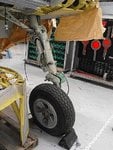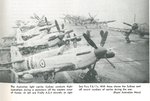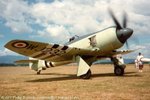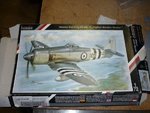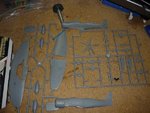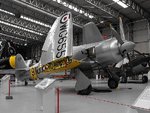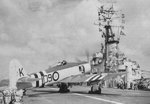parsifal
Colonel
Well, here goes nothin....my first group build and just my 5th build of all time (one of which was a total failure. Am I nervous??? you bet.... But I am hopeful that I can do the subject some justice....
Hawker Sea Fury Royal Australian Navy - My Favourite Aircraft Of All Time
User name: Parsifal
Name: Michael
Category: 1, Beginner
Kit: Special Hobby" Hawker Sea Fury FB Mk11 805 Sqn HMAS Sydney CAG Korean War era
Scale: 1/72.
Accessories: Cockpit photoetching kit and aftermarket decals for RAN
My first entry in any group build for the Favourite Aircraft Of All Time Group Build is a Hawker Sea Fury Royal Australian Navy FAA, as they appeared during the Korean War.
Some background of 805 Sqn
"805 Squadron was originally commissioned as a Royal Navy (RN) fighter squadron in May 1940. The unit disbanded and reformed several times during WWII serving in Crete, Africa and the Pacific before disbanding for the final time (as a RN squadron) in 1948.
805 Squadron re-formed as the Royal Australian Navy's (RAN) first fighter squadron on 28 August 1948 at Royal Naval Air Station (RNAS) Eglinton in Northern Ireland. Flying Hawker Sea Fury F.B. II's and commanded by Lieutenant Commander P.E.I. Bailey, RN, the Squadron formed part of the 20th Carrier Air Group (CAG) along with 816 Squadron.
HMAS Sydney, the RAN's first aircraft carrier, was commissioned on 16 December 1948 at Devonport in the south of England. 20th CAG was assigned as its air group consisting of Furies and Fireflies
The CAG embarked in Sydney on 15 February 1949 and spent the next few weeks working up at Moray Firth. All of the pilots and observers in the CAG had extensive wartime operational experience but many had little or no deck landing experience.
Sydney departed for Australia on 12 April 1949 and arrived at Jervis Bay on 25 May 1949. Fifty-four aircraft were ferried ashore and then towed some 30 km by road to HMAS Albatross where aircrews found conditions somewhat primitive. Albatross was the RAN's first naval air station. While it was constructed on the site of a never-completed wartime airfield, it was still very much under construction when the first occupants arrived. Most of the aircrews and their families lived in caravans, extended with large packing cases used to ship Spitfires, at the Nowra showgrounds.
20th CAG re-embarked in Sydney in mid-January 1951, after the ship had been back to the UK to pick up the 21st CAG, and met the ship's new Executive Officer, Commander (later Admiral Sir) Victor Smith. Later that day, Smith introduced the entire CAG officer complement (about 35 people) to his captain virtually name and rank perfect even though it was the first time he had met most of them.
In February/March 1951 with the 20th CAG embarked, Sydney joined dozens of warships from a number of countries including the UK, Canada and New Zealand in a series of exercises in the Storm Bay area of south-eastern Tasmania. During the trip, a Sea Fury of 805 Squadron, piloted by Lieutenant (later Lieutenant Commander) Peter Seed, accidentally fired four rockets, one of which struck the Royal New Zealand Navy's flagship, HMNZS Bellona.
The incident raised some discussion about how the rockets fired. Seed was adamant that they just fired themselves though no fault was found in the rocket firing circuit. Later, during Sydney's first tour in Korea, it was discovered that the Sea Furies' armament circuits were susceptible to radiation at certain frequencies from the ship's radio aerials offering a possible explanation for the accident.
In May 1951 805 Squadron received orders that it was to comprise part of a new Sydney Carrier Air Group along with 808 and 817 Squadrons and would be departing for Korea later that year. The new CAG was to be commanded by Commander (later Vice Admiral Sir) Mike Fell, RN. Fell was himself, as a Lieutenant Commander, a former commanding officer of 805 Squadron's earlier RN incarnation. The Squadron was now commanded by Lieutenant Commander Walter Bowles.
805 Squadron departed for Korea aboard HMAS Sydney on 31 August 1951, with DD HMAS Tobruk in company as her escort, and arrived in Japan on 19 September 1951
Participating in 'Operation Strangle,' which was intended to cut enemy supply and communications to the front lines, Sydney would share patrol duties on Korea's west coast with Royal Navy (RN) and US Navy (USN) carriers as part of Task Force 95, United Nations Blockade and Escort Force. Operations would normally entail ground attack including close air support for ground forces, armed reconnaissance, spotting for ships guns and anti-shipping strikes. In addition, the CAG, now bearing the black and white markings of the United Nations, would maintain a Combat Area Patrol (CAP) during daylight hours to protect Sydney in the event of an air attack.
The CAG conducted its first raids on 5 October 1951 with 32 sorties mounted in the 'Wales' area in the south-west of North Korea. Six days later, Sydney's CAG flew a light fleet carrier record to date of 89 sorties in one day conducting attacking raids and targeting sorties for USS New Jersey. This exceptional performance drew high praise from the British Commander-in-Chief Far East Station:
"Your air effort in the last two days, unprecedented in quantity and high in quality, has been a magnificent achievement on which I warmly congratulate you. Though it is invidious to particularise - the spotters especially did a first class job and New Jersey with [the Commander of the] 7th Fleet embarked said they were the best she has had yet. Eighty-nine sorties in one day is grand batting by any standards, particularly in the opening match..."
Sydney lost three aircraft on her second patrol, one of them from 805 Squadron in one of the more unusual occurrences of the war. On 26 October 1951, Sub Lieutenant Noel Knappstein was hit by flak while attacking ground targets at the mouth of the Han River. Knappstein force landed his Sea Fury on the nearby island of Kyodong Do in the Han Estuary, just south of the 38th Parallel. Realising that the plane was a write-off, he salvaged what he could and sold the remainder of the wreck to some local villagers for about 1000 Wong. He was rescued shortly afterwards by HMS Amethyst which was then ordered to retrieve some more much needed and scarce equipment from the downed aircraft. The landing party was confronted by a farmer armed with a blunderbuss gun (an 18th century forerunner to a shotgun) determined to protect his new acquisition. Following some diplomatic discussions, the equipment was retrieved peacefully. Once he had converted the huge wad of cash into Australian currency, the entrepreneurial Knappstein's haul from the exercise amounted to one shilling and nine pence.
The realities of war, however, certainly took their toll on 805 Squadron. Sydney's CAG lost three aircrew during the Korean War, all from 805 Squadron. Lieutenant Keith Clarkson was killed when his aircraft was struck by enemy fire while diving on a road convoy on 5 November 1951. He never recovered from the dive. Clarkson's death shocked the rest of the CAG not just because he was their first fatality, but also because he was 805 Squadron's Senior Pilot and one of the most experienced pilots in the CAG, having served in WWII with the Royal Australian Air Force.
805 Squadron suffered their second loss on 7 December 1951 when Sub Lieutenant Richard Sinclair was hit by flak north-west of Chinnampo. His aircraft lost oil pressure and the engine caught fire forcing him to bail out. However, Sinclair was killed when he was struck by the tailplane of his Sea Fury. He was the father of a one month old baby back home in Australia.
The Squadron's final loss was that of Sub Lieutenant Ronald Coleman who went missing on 2 January 1952 during an otherwise uneventful CAP over the Yellow Sea. Coleman disappeared into cloud and was never seen again. With weather conditions and visibility extremely poor, Sydney launched an arduous, but ultimately fruitless, search.
Sydney's last raids were scheduled for 25 January 1952, striking directly on the North Korean capital of Pyongyang. Extremely poor weather, however, meant that the mission was cancelled and Sydney returned to Australia a few days later via Sasebo and Hong Kong.
Collectively, Sydney's CAG had flown 2366 sorties for the loss of three lives (all from 805 Squadron) and 14 aircraft (five of which were lost overboard or damaged beyond repair by Typhoon Ruth). Sydney had achieved an enviable operational record in Korea and it was noted that enemy activity decreased significantly in Sydney's area of operations.
Sydney arrived in Fremantle on 22 February 1952 in the middle of industrial unrest on the waterfront. Union action meant that no tugs arrived to pull Sydney out of the harbour on its departure date 3 days later. In response, the ship initiated an action known as 'Operation Pinwheel.' The Sea furies of 805 and 808 Squadrons simply started the engines of the aircraft sitting on Sydney's flightdeck to pull herself clear.
I intend to replicate Lt Knappsteins mount on the day of its loss. I believe it fitting, as this was the first squadron loss under combat conditions. Serial Number VX728 (RAN code 103/K, 22/10/51, LEUT(P) Knapstein, RAN. Hit bt flak and force landed onto a mud flat on the South bank of the HAN River.Rescued by a boat from HMS Amethyst.
The Kit
The Special Hobby Kit is a first for me…..it looks pretty straightforward, but then we will see."
Hawker Sea Fury Royal Australian Navy - My Favourite Aircraft Of All Time
User name: Parsifal
Name: Michael
Category: 1, Beginner
Kit: Special Hobby" Hawker Sea Fury FB Mk11 805 Sqn HMAS Sydney CAG Korean War era
Scale: 1/72.
Accessories: Cockpit photoetching kit and aftermarket decals for RAN
My first entry in any group build for the Favourite Aircraft Of All Time Group Build is a Hawker Sea Fury Royal Australian Navy FAA, as they appeared during the Korean War.
Some background of 805 Sqn
"805 Squadron was originally commissioned as a Royal Navy (RN) fighter squadron in May 1940. The unit disbanded and reformed several times during WWII serving in Crete, Africa and the Pacific before disbanding for the final time (as a RN squadron) in 1948.
805 Squadron re-formed as the Royal Australian Navy's (RAN) first fighter squadron on 28 August 1948 at Royal Naval Air Station (RNAS) Eglinton in Northern Ireland. Flying Hawker Sea Fury F.B. II's and commanded by Lieutenant Commander P.E.I. Bailey, RN, the Squadron formed part of the 20th Carrier Air Group (CAG) along with 816 Squadron.
HMAS Sydney, the RAN's first aircraft carrier, was commissioned on 16 December 1948 at Devonport in the south of England. 20th CAG was assigned as its air group consisting of Furies and Fireflies
The CAG embarked in Sydney on 15 February 1949 and spent the next few weeks working up at Moray Firth. All of the pilots and observers in the CAG had extensive wartime operational experience but many had little or no deck landing experience.
Sydney departed for Australia on 12 April 1949 and arrived at Jervis Bay on 25 May 1949. Fifty-four aircraft were ferried ashore and then towed some 30 km by road to HMAS Albatross where aircrews found conditions somewhat primitive. Albatross was the RAN's first naval air station. While it was constructed on the site of a never-completed wartime airfield, it was still very much under construction when the first occupants arrived. Most of the aircrews and their families lived in caravans, extended with large packing cases used to ship Spitfires, at the Nowra showgrounds.
20th CAG re-embarked in Sydney in mid-January 1951, after the ship had been back to the UK to pick up the 21st CAG, and met the ship's new Executive Officer, Commander (later Admiral Sir) Victor Smith. Later that day, Smith introduced the entire CAG officer complement (about 35 people) to his captain virtually name and rank perfect even though it was the first time he had met most of them.
In February/March 1951 with the 20th CAG embarked, Sydney joined dozens of warships from a number of countries including the UK, Canada and New Zealand in a series of exercises in the Storm Bay area of south-eastern Tasmania. During the trip, a Sea Fury of 805 Squadron, piloted by Lieutenant (later Lieutenant Commander) Peter Seed, accidentally fired four rockets, one of which struck the Royal New Zealand Navy's flagship, HMNZS Bellona.
The incident raised some discussion about how the rockets fired. Seed was adamant that they just fired themselves though no fault was found in the rocket firing circuit. Later, during Sydney's first tour in Korea, it was discovered that the Sea Furies' armament circuits were susceptible to radiation at certain frequencies from the ship's radio aerials offering a possible explanation for the accident.
In May 1951 805 Squadron received orders that it was to comprise part of a new Sydney Carrier Air Group along with 808 and 817 Squadrons and would be departing for Korea later that year. The new CAG was to be commanded by Commander (later Vice Admiral Sir) Mike Fell, RN. Fell was himself, as a Lieutenant Commander, a former commanding officer of 805 Squadron's earlier RN incarnation. The Squadron was now commanded by Lieutenant Commander Walter Bowles.
805 Squadron departed for Korea aboard HMAS Sydney on 31 August 1951, with DD HMAS Tobruk in company as her escort, and arrived in Japan on 19 September 1951
Participating in 'Operation Strangle,' which was intended to cut enemy supply and communications to the front lines, Sydney would share patrol duties on Korea's west coast with Royal Navy (RN) and US Navy (USN) carriers as part of Task Force 95, United Nations Blockade and Escort Force. Operations would normally entail ground attack including close air support for ground forces, armed reconnaissance, spotting for ships guns and anti-shipping strikes. In addition, the CAG, now bearing the black and white markings of the United Nations, would maintain a Combat Area Patrol (CAP) during daylight hours to protect Sydney in the event of an air attack.
The CAG conducted its first raids on 5 October 1951 with 32 sorties mounted in the 'Wales' area in the south-west of North Korea. Six days later, Sydney's CAG flew a light fleet carrier record to date of 89 sorties in one day conducting attacking raids and targeting sorties for USS New Jersey. This exceptional performance drew high praise from the British Commander-in-Chief Far East Station:
"Your air effort in the last two days, unprecedented in quantity and high in quality, has been a magnificent achievement on which I warmly congratulate you. Though it is invidious to particularise - the spotters especially did a first class job and New Jersey with [the Commander of the] 7th Fleet embarked said they were the best she has had yet. Eighty-nine sorties in one day is grand batting by any standards, particularly in the opening match..."
Sydney lost three aircraft on her second patrol, one of them from 805 Squadron in one of the more unusual occurrences of the war. On 26 October 1951, Sub Lieutenant Noel Knappstein was hit by flak while attacking ground targets at the mouth of the Han River. Knappstein force landed his Sea Fury on the nearby island of Kyodong Do in the Han Estuary, just south of the 38th Parallel. Realising that the plane was a write-off, he salvaged what he could and sold the remainder of the wreck to some local villagers for about 1000 Wong. He was rescued shortly afterwards by HMS Amethyst which was then ordered to retrieve some more much needed and scarce equipment from the downed aircraft. The landing party was confronted by a farmer armed with a blunderbuss gun (an 18th century forerunner to a shotgun) determined to protect his new acquisition. Following some diplomatic discussions, the equipment was retrieved peacefully. Once he had converted the huge wad of cash into Australian currency, the entrepreneurial Knappstein's haul from the exercise amounted to one shilling and nine pence.
The realities of war, however, certainly took their toll on 805 Squadron. Sydney's CAG lost three aircrew during the Korean War, all from 805 Squadron. Lieutenant Keith Clarkson was killed when his aircraft was struck by enemy fire while diving on a road convoy on 5 November 1951. He never recovered from the dive. Clarkson's death shocked the rest of the CAG not just because he was their first fatality, but also because he was 805 Squadron's Senior Pilot and one of the most experienced pilots in the CAG, having served in WWII with the Royal Australian Air Force.
805 Squadron suffered their second loss on 7 December 1951 when Sub Lieutenant Richard Sinclair was hit by flak north-west of Chinnampo. His aircraft lost oil pressure and the engine caught fire forcing him to bail out. However, Sinclair was killed when he was struck by the tailplane of his Sea Fury. He was the father of a one month old baby back home in Australia.
The Squadron's final loss was that of Sub Lieutenant Ronald Coleman who went missing on 2 January 1952 during an otherwise uneventful CAP over the Yellow Sea. Coleman disappeared into cloud and was never seen again. With weather conditions and visibility extremely poor, Sydney launched an arduous, but ultimately fruitless, search.
Sydney's last raids were scheduled for 25 January 1952, striking directly on the North Korean capital of Pyongyang. Extremely poor weather, however, meant that the mission was cancelled and Sydney returned to Australia a few days later via Sasebo and Hong Kong.
Collectively, Sydney's CAG had flown 2366 sorties for the loss of three lives (all from 805 Squadron) and 14 aircraft (five of which were lost overboard or damaged beyond repair by Typhoon Ruth). Sydney had achieved an enviable operational record in Korea and it was noted that enemy activity decreased significantly in Sydney's area of operations.
Sydney arrived in Fremantle on 22 February 1952 in the middle of industrial unrest on the waterfront. Union action meant that no tugs arrived to pull Sydney out of the harbour on its departure date 3 days later. In response, the ship initiated an action known as 'Operation Pinwheel.' The Sea furies of 805 and 808 Squadrons simply started the engines of the aircraft sitting on Sydney's flightdeck to pull herself clear.
I intend to replicate Lt Knappsteins mount on the day of its loss. I believe it fitting, as this was the first squadron loss under combat conditions. Serial Number VX728 (RAN code 103/K, 22/10/51, LEUT(P) Knapstein, RAN. Hit bt flak and force landed onto a mud flat on the South bank of the HAN River.Rescued by a boat from HMS Amethyst.
The Kit
The Special Hobby Kit is a first for me…..it looks pretty straightforward, but then we will see."
Last edited by a moderator:

